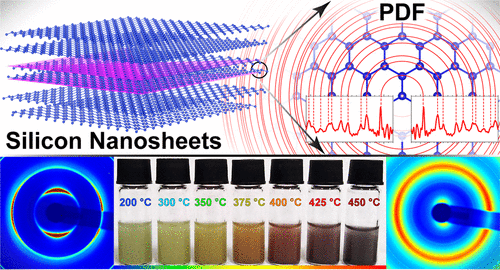Our official English website, www.x-mol.net, welcomes your
feedback! (Note: you will need to create a separate account there.)
Anisotropic Disorder and Thermal Stability of Silicane
ACS Nano ( IF 15.8 ) Pub Date : 2021-09-10 , DOI: 10.1021/acsnano.1c04230 Bradley J Ryan 1 , Luke T Roling 1 , Matthew G Panthani 1
ACS Nano ( IF 15.8 ) Pub Date : 2021-09-10 , DOI: 10.1021/acsnano.1c04230 Bradley J Ryan 1 , Luke T Roling 1 , Matthew G Panthani 1
Affiliation

|
Atomically thin silicon nanosheets (SiNSs), such as silicane, have potential for next-generation computing paradigms, such as integrated photonics, owing to their efficient photoluminescence emission and complementary-metal-oxide-semiconductor (CMOS) compatibility. To be considered as a viable material for next-generation photonics, the SiNSs must retain their structural and optical properties at operating temperatures. However, the intersheet disorder of SiNSs and their nanoscale structure makes structural characterization difficult. Here, we use synchrotron X-ray diffraction and atomic pair distribution function (PDF) analysis to characterize the anisotropic disorder within SiNSs, demonstrating they exhibit disorder within the intersheet spacing, but have little translational or rotational disorder among adjacent SiNSs. Furthermore, we identify changes in their structural, chemical, and optical properties after being heated in an inert atmosphere up to 475 °C. We characterized changes of the annealed SiNSs using synchrotron-based total X-ray scattering, infrared spectroscopy, X-ray photoelectron spectroscopy, scanning electron microscopy, electron paramagnetic resonance, absorbance, photoluminescence, and excited-state lifetime. We find that the silicon framework is robust, with an onset of amorphization at ∼300 °C, which is well above the required operating temperatures of photonic devices. Above ∼300 °C, we demonstrate that the SiNSs begin to coalesce while keeping their translational alignment to yield amorphous silicon nanosheets. In addition, our DFT results provide information on the structure, energetics, band structures, and vibrational properties of 11 distinct oxygen-containing SiNSs. Overall, these results provide critical information for the implementation of atomically thin silicon nanosheets in next-generation CMOS-compatible integrated photonic devices.
中文翻译:

硅胶的各向异性无序与热稳定性
由于其高效的光致发光发射和互补金属氧化物半导体 (CMOS) 兼容性,原子级薄的硅纳米片 (SiNS),例如硅烷,具有用于下一代计算范式的潜力,例如集成光子学。为了被视为下一代光子学的可行材料,SiNS 必须在工作温度下保持其结构和光学特性。然而,SiNSs 的片间无序及其纳米级结构使结构表征变得困难。在这里,我们使用同步加速器 X 射线衍射和原子对分布函数 (PDF) 分析来表征 SiNS 内的各向异性无序,证明它们在片间距内表现出无序,但在相邻的 SiNS 之间几乎没有平移或旋转无序。此外,在惰性气氛中加热至 475 °C 后,我们确定了它们的结构、化学和光学特性的变化。我们使用基于同步加速器的总 X 射线散射、红外光谱、X 射线光电子能谱、扫描电子显微镜、电子顺磁共振、吸光度、光致发光和激发态寿命来表征退火的 SiNSs 的变化。我们发现硅框架是坚固的,在~300°C 开始非晶化,这远高于光子器件所需的工作温度。在~300°C 以上,我们证明了 SiNSs 开始聚结,同时保持它们的平移排列以产生非晶硅纳米片。此外,我们的 DFT 结果提供了有关结构、能量学、能带结构、11 种不同的含氧 SiNS 的振动特性。总体而言,这些结果为在下一代兼容 CMOS 的集成光子器件中实现原子级薄硅纳米片提供了关键信息。
更新日期:2021-09-28
中文翻译:

硅胶的各向异性无序与热稳定性
由于其高效的光致发光发射和互补金属氧化物半导体 (CMOS) 兼容性,原子级薄的硅纳米片 (SiNS),例如硅烷,具有用于下一代计算范式的潜力,例如集成光子学。为了被视为下一代光子学的可行材料,SiNS 必须在工作温度下保持其结构和光学特性。然而,SiNSs 的片间无序及其纳米级结构使结构表征变得困难。在这里,我们使用同步加速器 X 射线衍射和原子对分布函数 (PDF) 分析来表征 SiNS 内的各向异性无序,证明它们在片间距内表现出无序,但在相邻的 SiNS 之间几乎没有平移或旋转无序。此外,在惰性气氛中加热至 475 °C 后,我们确定了它们的结构、化学和光学特性的变化。我们使用基于同步加速器的总 X 射线散射、红外光谱、X 射线光电子能谱、扫描电子显微镜、电子顺磁共振、吸光度、光致发光和激发态寿命来表征退火的 SiNSs 的变化。我们发现硅框架是坚固的,在~300°C 开始非晶化,这远高于光子器件所需的工作温度。在~300°C 以上,我们证明了 SiNSs 开始聚结,同时保持它们的平移排列以产生非晶硅纳米片。此外,我们的 DFT 结果提供了有关结构、能量学、能带结构、11 种不同的含氧 SiNS 的振动特性。总体而言,这些结果为在下一代兼容 CMOS 的集成光子器件中实现原子级薄硅纳米片提供了关键信息。











































 京公网安备 11010802027423号
京公网安备 11010802027423号